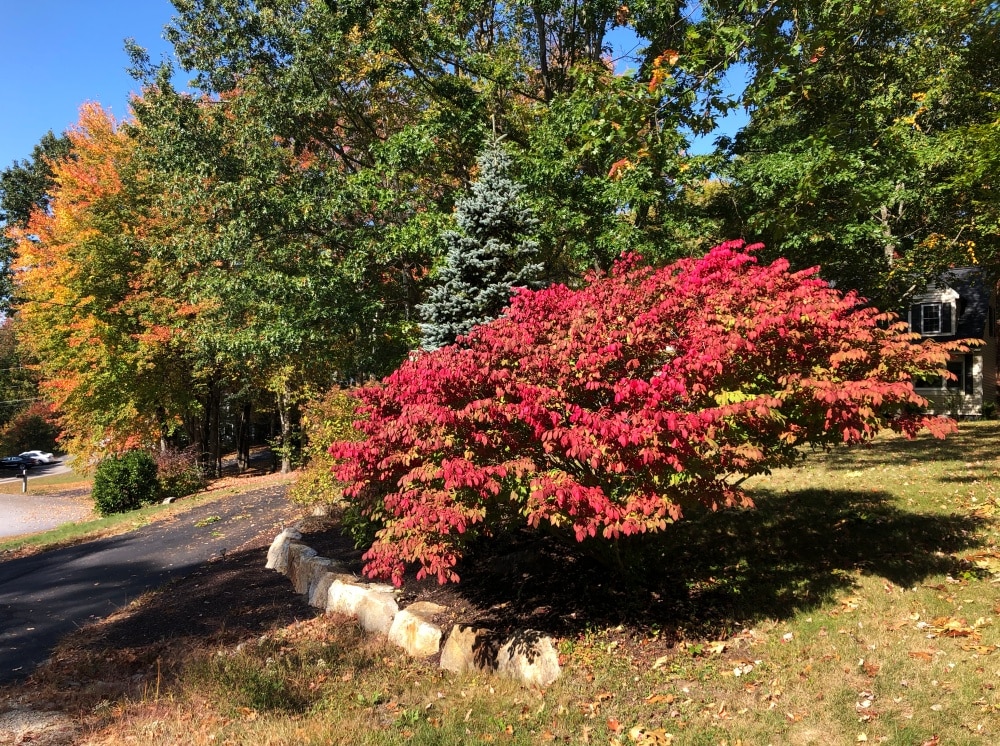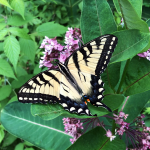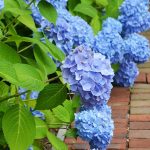For years, burning bush was a widely-available suburban shrub, but not anymore. Is burning bush invasive? Read on to learn more.
This year I tried to buy more burning bush for our yard because I like the fall color, but our local nursery has discontinued carrying them. They told us burning bush is considered an invasive plant, and instead recommended several other types. Why is this?—
L.M, Storrs, CT
Your garden center is right — burning bush (
Euonymus alatus) and all its cultivars have been identified as a threat to natural areas because they seed in so prolifically and become dominant, forcing out other important plants. Learn more about
Invasive Plant Species in New England. Massachusetts and New Hampshire now have laws that prohibit the sale of burning bush along with several other commonly used landscape plants. Until a sterile (non-seed-producing) form of burning bush is developed, these familiar plants will become increasingly unavailable on the market. Depending on your level of concern about the effects of invasive plants on the environment, you may even want to consider removing those original plants, replacing them with less invasive types.
Possible substitutes for burning bush are highbush blueberry (
Vaccinium corymbosum), brilliant chokeberry (
Aronia arbutifolia ‘Brilliantissima’), redvein enkianthus (
Enkianthus campanulatus), and sweet spire (Itea). All of these plants exhibit similar brilliant fall color, are climate hardy in your area, are readily available, and have not caused problems in natural areas. You can learn more about New England’s invasive plants by going to the Invasive Plant Atlas of New England Web site:
ipane.org.
Our perennial garden looks so overcrowded during summer and fall, but I don’t want to lose any of my colorful plants. Any suggestions? —K.G., Sherborn, MA
Autumn is a great time to observe your garden design and document ideas for change. When plants, particularly herbaceous perennials, are just starting to grow in spring, it’s always tempting to fill “open” spaces with more plants. As they grow to their natural mature size during the year, the beauty of all your plants may be compromised because they become so crowded by their neighbors. Don’t be embarrassed — some of the most seasoned gardeners have the same problems!
This may not be the ideal time to transplant some of your plants. Early spring is always recommended if you are unsure. But take the time now to note the plants that are overcrowded and write down your plan for next season. Most importantly, insert name-tag labels next to each plant so you can find them next spring when they are still dormant. Once you know what you have, it’s easier to learn more about each plant’s requirements, envision where plants might be better used, and perhaps even consult with a professional garden designer for assistance.
This post was first published in 2015 and has been updated.
See More:









I have had 3 burning bushes (Euonymus) in my yard for 30 years. I have had 3 babies in all in 30 yrs germinate under them, which I gave away. I don’t tend these bushes they just grow & thrive on their own. I have 3 wild acres of land & have had only 1 stray Euonymus Burning bush grow in another part of my land, none on my neighboring land… IN 30 YEARS!!!! I don’t call that even a spreader, never mind invasive. Can’t prove it by me.
I have one very small burning bush that doesn’t appear to have grown at all in the 30+ years we’ve lived in our house. Our neighbors have a large one. Same thing–the size doesn’t appear to have changed in years. No babies around it, either. My take on it agrees with that of the previous commenter.
I couldn’t disagree more with the previous two posters. I fell in love with burning bush when we moved into our new home in 2004. We planted 9 of them in front of our stone wall in front the house. Absolutely beautiful color, but alas, babies everywhere in only two years. That year (2006) I was made aware of the plants’ invasive status (wish I had read up on it prior to purchase). I did nothing about it until 2012, when my husband hooked a huge chain to the back of his truck and pulled them all out. We left them in the top portion of our driveway, covered in black plastic to bake in the sun and die, and have never been happier. We now plant nothing but native species. To this day, we still remove tiny seedlings from all over our yard. We also removed all that Multiflora Rose that smells so beautiful in the spring, as well as probably 90% of the bittersweet strangling our woodland trees surrounding the property, and Japanese barberry from neighbors yards that have found their way to our yard. Just because a plant doesn’t seem to be invasive in your own yard, doesn’t mean it hasn’t spread beyond. Birds and mice all help to spread those thousands of tiny little seeds everywhere. The plants that I have named here have taken over thousands of surrounding acres in my neighborhood, strangled trees, filled in wetlands, and in general are a terrible nuisance. Plant native and you won’t go wrong.
I have a Burning Bush that I planted in 2002 and it has grown into a lovely size. I bought it at Wal-Mart for $5.97. I live in NH, and they are not available here any longer. It has never produced any smaller babies. Its just a very beautiful bush that has extraordinary color in the fall!
I bought a burning bush at a nursery and planted it in front yard. Shortly after, I found a small one growing in the woods behind my house and dug it up, planting it beside the house. They never made any babies.
The person we bought our house from must have loved Burning Bush because he planted them everywherein rows as hedges and as specimens in groupings, and to top it all off they have seeded in other areas as well. So far I have had three of his hedges removed and continue to pull out others wherever I can. While I love the fall color I would happily do without if I could get rid of them all. Unfortunately if I have them removed along one if the rock walls I will see my neighbors house and their unkempt former flower beds.
I have had one for 25 years and it has never caused us any problem in our landscape. My husband has discovered that most of these bands go back to the Bible where they are mentioned by their proper name and thats the true reason for the band!
We purchased a property that has a gorgeous Burning Bush in the back yard and colonies of it radiating outward. It will take me a decade just to dig all these out. This was an old perennial gardens and I’ve got all the baddies in abundance. They made and sold wreaths, so the Bittersweet has gone crazy, choking out old established fruit trees. Barbary, a tick vector, is about half eradicated so far, but the BlackBerry vines are making it difficult to get to half our property to get the rest. This is what happens when someone gets I’ll and quits tending all those foreign invasive. Had I only known, I think we wouldn’t have purchased this place.
Having seedling in your yard is not the issue here. The birds eat the seeds and deposit them in fields and wooded areas. Its not the ones you see, its the ones you don’t see.
So because the birds eat the seeds and deposit them elsewhere we can’t buy these any longer? Doesn’t that happen with a lot of other plants?
I don’t believe this plant grows as invasive , we have rows here and I live in a area with lots of types of plants that grow by themselves and I have to say I never saw any other burning bush beside the ones The previous owner have planted, never grew anywhere.. one thing grows like weed is the oak trees and Lynwood Gold Forsythia Shrub they grow everywhere and this forsythia kills everything around .. burning bush never saw anywhere in the yard. Which is 2.4 acres think the people that killed them believe in anything they hear No proof on this.
I don’t think it is either. I’m in zone 7a. I’m trying to imagine how. Their root system doesn’t spread and send up new plants and I’m trying to imagine any ‘fruit’ associated with this fall beauty.
In just over five years, burning bush has taken over a large area of woods alongside our road, just down hill from a house that has it planted. It is smothering the understory and will eventually kill the forest.
We have six of them in our yard here in Western New York. I have never seen any evidence of babies anywhere. Maybe it’s our weather and hard clay soil that makes them non invasive?
Smile)). Same with folks screaming about my absolute fall favorite, Nandina. So, all of a sudden birds are dying from eating the berries? Is this a new thing? They’ve co-existed for a long time.
Love burning bush!
A friend of mine is a landscape architect and plant geek. Shortly after buying my NH home, he walked through our woods with me, pointing out all the barberry and burning bush seedlings that were choking out natives. Invasive aren’t about curated landscapes as much as wild areas. Trust the experts.
This is not true. IMHO, they have probably targeted this bush because of its popularity and to begin control of what plants and seeds we plant. We’ve had burning bushes in our back yard – growing right next to a Forsythia bush and a Rose of Sharon with zero problems. There is nothing “invasive” about it – other than you can root it easily…. (hint, hint) The more sun they get, the more vibrant they are in the fall. They are beautiful bushes and are, or were, very popular throughout New England. So, yes, this “designation” is total B.S.
i agree i have owned three burning bushes 30 yrs and they are the only three on my 15 acres , to many people li ke to try to control what one can own and have
Burning Bush is very invasive! Do not plant it! I pulled up and cut down tons of Burning Bushes in the woods behind my house. I replaced them with native Nannyberry Viburnum and native Witch Hazel. I also dug up a Burning Bush in our landscaping. I did not know it was invasive when we bought it. I planted a native Service Berry in its place. Shame on garden centers for knowingly selling invasive to unsuspecting customers! I encourage everyone to talk to your garden centers and ask them to sell natives and quit selling invasives. There are many native alternatives to burning bush. All of the above native plants I mentioned, have nice fall colors. All of them also are host plants for birds, caterpillars and butterflies. Nannyberry Viburnum and Seviceberry provide 3 or 4 seasons of interest and Serviceberry produces a delicious edible fruit. Native Witch Hazel has yellow flowers and leaves in the fall. Contrast this with Burning Bush which is a host plant to zero caterpillars/ butterflies and provides only one season of interest. As others have stated, just because there are no seedlings under the tree does not mean the birds are not carrying it elsewhere and spreading it. Planting native plants instead of invasives is a little thing everyone can do to help our planet and attract birds and butterflies.
Have had my one bush for at least 20 yrs and HAVE NEVER seen 1 seedling from it. GLoucester
I have one in my suburban yard for 25 years(+) and it has not spread at all. Not sure why that is? But it is beautiful in the Fall.
We had one beautiful sterile dwarf burning bush in the corner of our yard. The power company cut it down. Very sad.
We planted 2 burning bush 30 yrs ago and they grew nicely but never spread in my backyard or in the state forest behind the house. We walked there every day and we are on the lookout but we can’t see any seedlings. Maybe we got the sterile plants.
We have a couple of Burning Bushes in our yard, which were here when we purchased our house 30 years ago. They have grown quite a bit and and they are spectacular in the fall, and give us some privacy nowadays because they are between the house and the road. A few years ago I read that they are considered an “invasive” species, and for awhile that worried me. But I have continued to love them—more and more as each year goes by. Perhaps they reproduce easily, but they also provide food for birds and perhaps other animals, and they provide so much beauty! I see seedlings popping up in the yard now and then, which get chopped right down as I mow the lawn. Occasionally I see small ones in the woods, but because they don’t get much light because under the various trees, especially the tall pines, they never get very large. In recent years I have begun to think of the “native plants only” movement as misguided, because it seems too much like the somewhat similar anti-immigrant comments I read about in the paper, and see on TV, From the founding of our country there have been immigrant people AND immigrant plants. We should welcome them all —except for the actually-noxious ones— enjoy them, and find a way to live peaceably with them.
nice article……Think We will plant one or two….And keep an eye on them ……Hope We do not have get the tug and chain out…
Please please please…gardening involves great power to change landscapes of the future. The people planting Rosa multiflora along the roads and for “wildlife food” had no idea how invasive they were, and now the costs are huge to try to control it. If it is not invasive in your yard now, you are simply lucky. Just because you don’t have a problem with it does not mean the problem does not exist. I cannot understand how any responsible citizen would not jump to prevent a forestry issue in their area. You may be in an area where a lot of plants have not yet been introduced, meaning they are not reproducing yet. Your plant may not be in soil, moisture, or light conditions that encourage viable seeds. There are lots of reasons for this circumstance. Here is a very well written piece on the subject I hope people will have open-mindedness to read.
https://haltonmastergardeners.com/2020/05/21/its-not-invasive-in-my-garden-whats-the-harm/